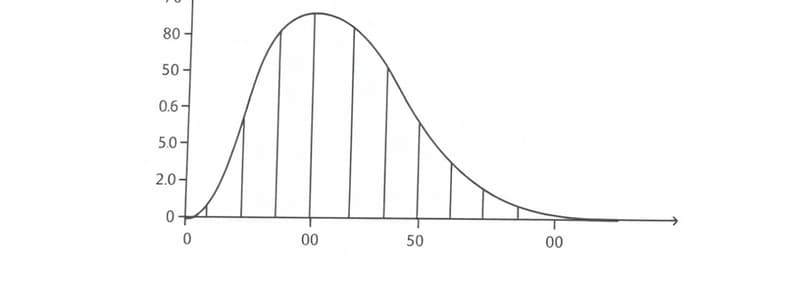Podcast
Questions and Answers
How is the sum of squares (SS) defined in the computational formula for the sample variance?
How is the sum of squares (SS) defined in the computational formula for the sample variance?
The sum of squares is defined as (xi − x̄)^2 = xi^2 - nx̄^2.
What is the probability that fewer than 4,000 UTEP undergraduates are from the suburbs?
What is the probability that fewer than 4,000 UTEP undergraduates are from the suburbs?
0.5698 or 56.98%
What is the cutoff value for a BMI that defines being overweight (higher than 95% of the population)?
What is the cutoff value for a BMI that defines being overweight (higher than 95% of the population)?
27.62
What is the proportion of adults considered obese (BMI above 30)?
What is the proportion of adults considered obese (BMI above 30)?
What is the likelihood that the average BMI of 10 randomly selected adults is above 25?
What is the likelihood that the average BMI of 10 randomly selected adults is above 25?
What is the probability that the sample variance s² is greater than 2?
What is the probability that the sample variance s² is greater than 2?
What is the variance of X if X follows a chi-square distribution with v degrees of freedom?
What is the variance of X if X follows a chi-square distribution with v degrees of freedom?
What is Markov's inequality regarding a nonnegative random variable X and a positive constant a?
What is Markov's inequality regarding a nonnegative random variable X and a positive constant a?
What is the distribution of the sample average X̄ from a random sample of Exponential(λ) distribution?
What is the distribution of the sample average X̄ from a random sample of Exponential(λ) distribution?
What is the variance of the average X̄ when sampling from Exponential(λ)?
What is the variance of the average X̄ when sampling from Exponential(λ)?
What R command might be used to compute the probability P(X̄ > 12) based on the distributions?
What R command might be used to compute the probability P(X̄ > 12) based on the distributions?
Study Notes
Sample Variance Formula
- The computational formula for sample variance involves the sum of squares (SS) quantity.
- This SS quantity can be expressed in three equivalent forms:
- The sum of squared deviations from the sample mean.
- The sum of squared observations minus n times the squared sample mean.
- The sum of squared observations minus the squared sum of observations divided by n.
Normal Approximation to Binomial Probability
- The problem involves calculating the probability of fewer than 4,000 UTEP undergraduates from the suburbs.
- The number of students from the suburbs can be modeled as a binomial distribution with n = 21,000 and p = 0.19.
- The Central Limit Theorem (CLT) allows us to approximate the binomial distribution with a normal distribution.
Cutoff Value for Overweight
- The problem concerns the cutoff value for overweight defined by a BMI exceeding the 95th percentile of the population.
- The BMI is normally distributed with a mean of 21.7 and a standard deviation of 3.6.
- The cutoff value for overweight is calculated using the 95th percentile of the standard normal distribution (1.645).
Proportion of Obese Adults
- The problem involves calculating the proportion of obese adults with a BMI exceeding 30.
- The proportion is calculated as the probability of a BMI exceeding 30, which is determined using the standard normal distribution.
Sampling Distribution of Average BMI
- The average BMI of a random sample of 10 adults is analyzed.
- The distribution of the sample mean BMI is normal with a mean of 21.7 and a variance of 3.6^2 / 10.
- The probability of the average BMI exceeding 25 is calculated using the standard normal distribution.
Sampling Distribution of Sample Variance
- The sample variance of BMI for a sample of 10 adults is analyzed.
- The distribution of the sample variance follows a chi-squared distribution with 9 degrees of freedom.
- The probability of the sample variance exceeding 2 is calculated using the chi-squared distribution.
Variance of a Chi-Squared Distribution
- The chi-squared distribution with ν degrees of freedom has a variance of 2ν.
- This can be proven using the moment generating function (MGF) of the chi-squared distribution.
Distribution of Linear Combinations of Normal Variables
- The problem involves identifying the distributions of specific linear combinations of independent standard normal variables.
- The distributions are identified by recognizing the properties of linear combinations of normal variables and applying the appropriate scaling and degrees of freedom.
Independence of Sample Mean and Deviations
- The problem explores the independence of the sample mean (X̄) and individual deviations from the mean (X_i - X̄).
- The independence is demonstrated by showing that the joint moment generating function (MGF) of X̄ and X_i - X̄ is equal to the product of their individual MGFs.
Independence of Individual Deviations and Sample Mean
- The problem analyzes the independence of two specific deviations (X1 - X2) and the sample mean (X̄).
- The independence is established by demonstrating that the covariance of the two is zero, which is a necessary and sufficient condition for independence in joint normal distributions.
Reciprocal of an F-Distribution
- The problem showcases a property of the F-distribution.
- If a random variable X follows an F-distribution with degrees of freedom v1 and v2, then the reciprocal of X (1/X) follows an F-distribution with degrees of freedom v2 and v1.
Markov's Inequality
- Markov's inequality provides an upper bound for the probability of a non-negative random variable exceeding a positive constant.
- The inequality states that the probability of X being greater than or equal to a is less than or equal to the expected value of X divided by a.
Distribution of Sample Average from Exponential Distribution
- The problem involves analyzing the distribution of the sample average (X̄) from an exponential distribution with parameter λ.
- The exact distribution of X̄ is a Gamma distribution with parameters n and nλ.
- The asymptotic distribution of X̄, by CLT, is a normal distribution with mean 1/λ and variance 1/(nλ^2).
- The accuracy of the asymptotic approximation is evaluated for different sample sizes (n) using R and compared to the exact distribution.
Studying That Suits You
Use AI to generate personalized quizzes and flashcards to suit your learning preferences.
Related Documents
Description
This quiz covers key concepts in statistics, including the computational formula for sample variance and the normal approximation to binomial probability. You'll explore various methods for calculating sample variance and applying the Central Limit Theorem (CLT) to a real-world scenario involving UTEP undergraduates. Additionally, the discussion includes determining cutoff values based on BMI percentiles.




